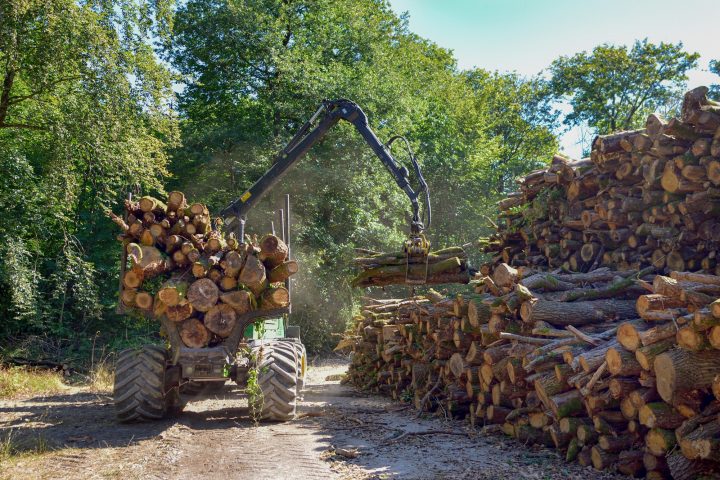Top Five Types of Forestry Equipment
In the United Kingdom, 44% of woodlands are certified as managed and sustainable.
Logging and forestry have been going on as long as human civilization has existed. Modern forestry equipment is large, powerful, and efficient. There are specific machines that Splitz Firewood & Mulch used for almost every aspect of timber harvesting, with some being more essential to the process than others.
Here are five types of forestry equipment that can make a huge difference in how effective any operation is.

1. The Chainsaw
This may surprise some people, but anyone who has worked in forestry knows the value of a good chainsaw. Chainsaws meant for forestry are often larger and more powerful than normal. They have larger boards and are able to cut through trees, logs, and branches with little hesitation.
The chainsaw is essential because a single person can carry and use it. It doesn’t need infrastructure, roads, or anything else to be effective. Chainsaws come in handy at every step of the forestry process and are useful in a variety of ways to help the workers at a job site.
With any piece of equipment that is large and powerful, chainsaws used in forestry are more expensive than civilian types. You can expect to pay for the extra power, larger board, and heavier steel construction. Compared to the other forestry equipment on this list, however, they are small and cheap.
2. Harvesters
A harvester is a piece of equipment that is vital to modern forestry work. It begins with a hydraulic excavator by removing and replacing the bucket with a harvester. This device is like a chainsaw made of sharp knives and it will tear through tree trunks, branches, and other obstructions easily.
You can use a harvester module to grip a tree and then cut it free. This removes the tree from the ground and enables the harvester to remove the branches and place the tree trunk in a pile for efficient removal. Without harvesters, the work of cutting down trees would take far more time and money.
Harvesters also have sensors that help to determine the size and cut of each log that they bring down. Diameter sensors and other high-tech additions make the harvester effective at collecting the proper size of timber. They are often tracked, but some models of the excavator can come with wheels, usually 4-6 wheels.
To get a harvester for your job site, you’re going to need to start with the base model of the excavator and then add the harvest attachment. This will increase the cost of the machine, but it is well worth it. Used forestry equipment can help save you money, as you won’t have to buy a brand new excavator and attachment.
3. Log Splitter
You can use log splitters to break down the trunks of trees before transporting them for sale or storage. With a modern log splitter, you can set it to produce logs of any size or shape. This can make stacking and storage much easier and reduces the need for additional manpower which saves time and money.
A log splitter can come in a variety of sizes, the larger the machine the bigger the logs it can handle. If you’re producing firewood for sale, this type of machine is often one of the only machines you’ll need. The versatility of log splitters makes them easy to set up, easy to use, and effective at shaping and forming the logs you need.
4. Loaders
No list of forestry equipment is complete without loaders. These are the machines that pick up the cut pieces of wood and place them on a trailer, pile, or truck. They can be stand-alone equipment, or they can function as part of a truck and crane.
An essential piece of forestry tools and equipment, loaders have a use at every job site to make the loading and transport of logs faster. Loaders can be expensive, often requiring forestry equipment loans. If you want a loader for your operation you can learn more about forestry finance.
As with harvesters, you can find forestry equipment sales that offer a loading attachment for a hydraulic excavator. This piece converts the excavator into a loader by adding powerful grippers and teeth which can handle any trunk or log. This also means that you can convert an excavator to take care of many different aspects of the operation.
5. Chipper
Forestry work does leave a lot of wood laying around that isn’t worth as much as the finished logs. For that debris, there are chippers that can turn a dense pile of brush into tiny fragments of wood in seconds. This is useful for transporting the chips, but also for cleaning up the job site and eliminating waste.
Wood chips can be sold on their own, which helps a forestry operation make money even on the pieces of wood they can’t use for logs. Most chippers are stand-alone machines, loaded from one side where a log is processed and then the chips are caught in a large metal hopper or truck.
If you’re doing forestry work and need a chipper you can purchase one outright or look into a forestry equipment rental. Chippers will need a truck with a large capacity as even a small amount of brush can produce a startling amount of wood chips.
Terrain and Your Equipment
The equipment presented here is often used in flat, level areas for work. If you’re operating on the slope of a mountain or hill you may need to look into other equipment options. Forestry equipment is designed to make your life easier, so make sure you get what your job site needs.
Forestry Equipment
The forestry industry has come a long way in the last century. From men with axes and long saws to mechanized forest clearing equipment, modern forestry equipment is an evolution of countless hours of long, hard work.
If this article was helpful to you, please take a moment and check out our website for more information.


